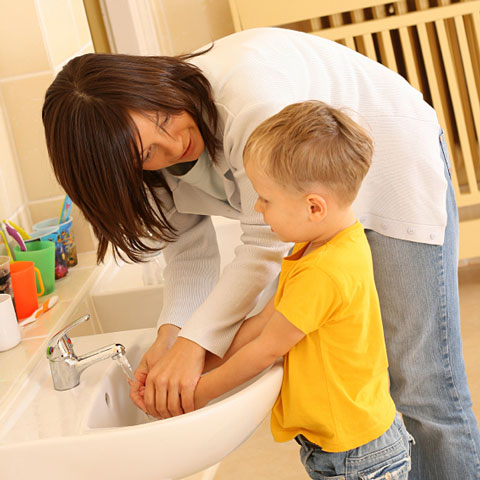Washing your hands often and well is an easy way to help prevent the spread of many infections, including the common cold. Illinois law sets standards for handwashing in childcare centers and day care homes.
What are the best times to wash hands?
Children should wash their hands as soon as they arrive at the school or childcare center AND…
- BEFORE going home
- AFTER using the bathroom or having diapers changed; handling pets or animals; sneezing, coughing, or blowing and/or wiping their nose; playing outside; or touching anything soiled with body fluids or wastes, such as blood, saliva, urine, stool, or vomit
- BEFORE AND AFTER using the water table or each meal or snack, cooking experience, or otherwise handling food
- ANYTIME hands look, feel, or smell unclean
Parents and teachers should wash their hands as soon as they arrive at the school or child care center AND…
- BEFORE going home
- AFTER using the bathroom or helping a child use the bathroom; changing a diaper; sneezing, coughing, blowing and/or wiping their nose, or helping a child wipe and/or blow their nose; handling items soiled with body fluids or waste (e.g., blood, drool, urine, stool, or vomit); handling pets or pet objects (e.g., cages or leashes); or handling or caring for a sick child
- BEFORE AND AFTER eating, drinking, or preparing, handling, or serving food; dispensing medication or administering first aid; changing rooms or caring for a different group of children
- ANYTIME hands look, feel, or smell unclean
What is the best way to wash hands?
- Use warm, but not hot, running water. Run the “cold” water first. Then, gradually increase the amount of warm water, testing the temperature yourself before the child puts her hands under the tap.
- Use soap. Apply enough liquid soap to develop a good lather. Lather the fronts, backs, between fingers, under fingernails, and up to the forearm areas of the hands. Scrub vigorously for at least 20 seconds. Rinse well.
- Dry your hands with a fresh paper towel. Then use the towel to turn off the faucet. Discard the towel.
- Help young children wash their hands using the above method. As they become experienced, you can teach them how to wash their hands while you supervise.
IEL Resource
- Resource List: Physical Health and Wellness
Web Resources
-
Part 407 Licensing Standards for Day Care Centers
Source: Illinois.gov
This document describes licensing standards for day care centers.


 PDF
PDF